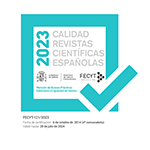Arte y simbolismo
Resumen
This article presents a thorough study of perhaps, from the speculative viewpoint, the most interesting fresco mural painted by Raphael Santi, one of the most excellent Italian Old Masters, whose praises have not ceased to be sung by connoisseurs in the near five centures elapsed since his decease. He was held to be a child prodigy and eventually turned out an extrensive and admirable output of masterìeces but, regrettably, his life was cut short when he was in his prime. The interest awakened by this particular painting, which is deemed to be “the epitome of the Italian High Renaissance”, focuses not only on its splendid pictorial and aesthetical merits but also on the richness of an explicit and implicit or underlying sybolism, which entails phylosophico-metaphysical messages of Neoplatonic derivation from Greek sources but to a large extent of Oriental origin.Descargas
Descarga artículo
Licencia
La revista Arte, Individuo y Sociedad, para fomentar el intercambio global del conocimiento, facilita el acceso sin restricciones a sus contenidos desde el momento de su publicación en la presente edición electrónica, y por eso es una revista de acceso abierto. Los originales publicados en esta revista son propiedad de la Universidad Complutense de Madrid y es obligatorio citar su procedencia en cualquier reproducción total o parcial. Todos los contenidos se distribuyen bajo una licencia de uso y distribución Creative Commons Reconocimiento 4.0 (CC BY 4.0). Esta circunstancia ha de hacerse constar expresamente de esta forma cuando sea necesario. Puede consultar la versión informativa y el texto legal de la licencia.










